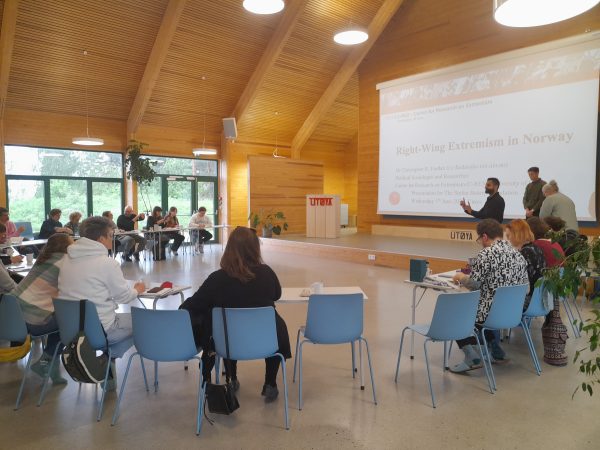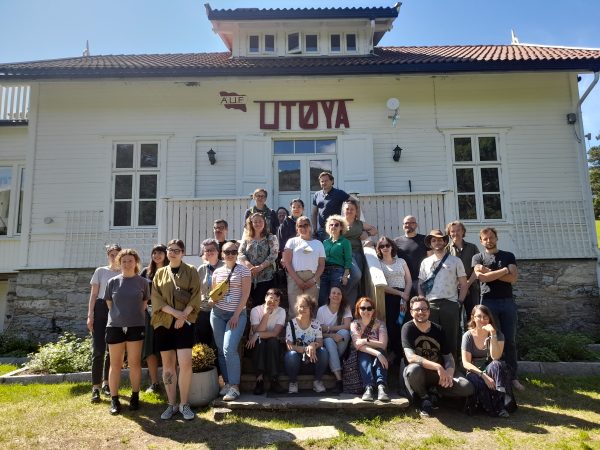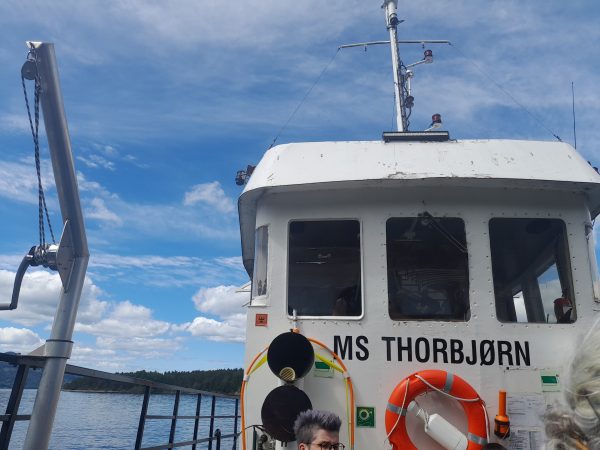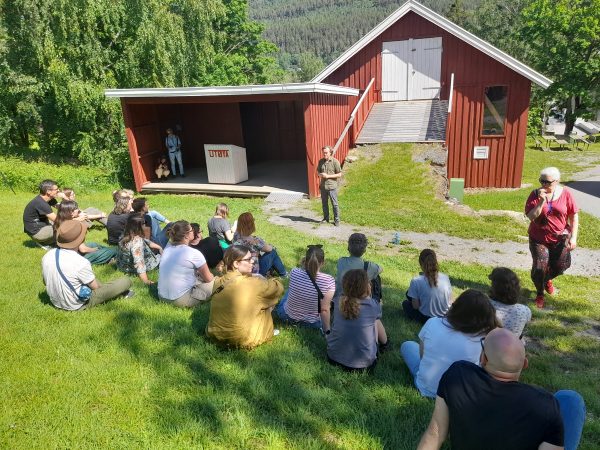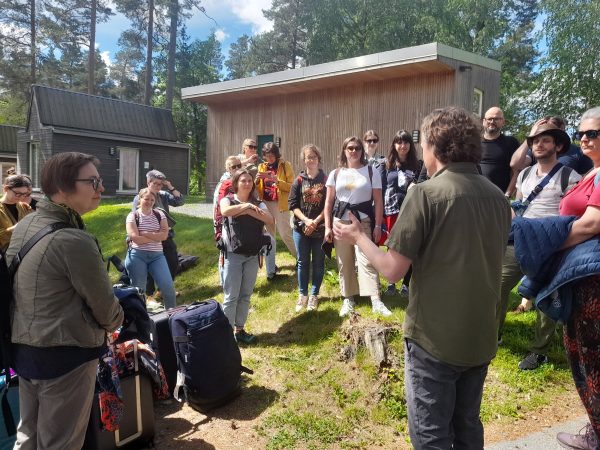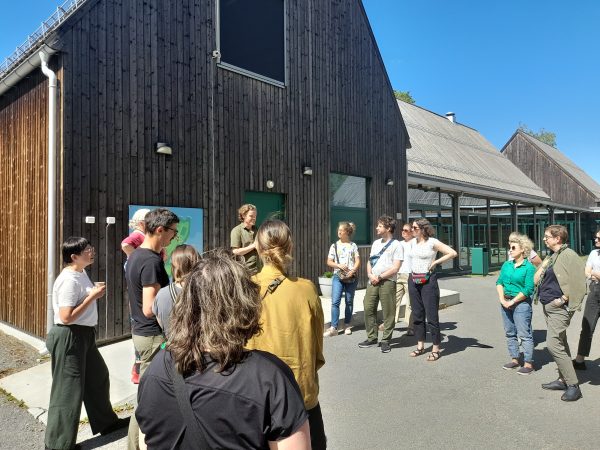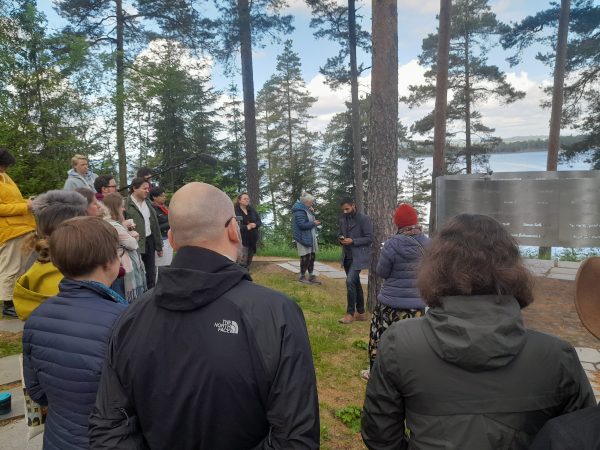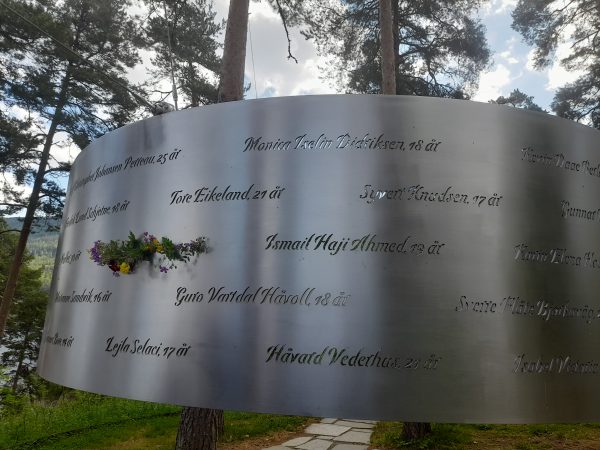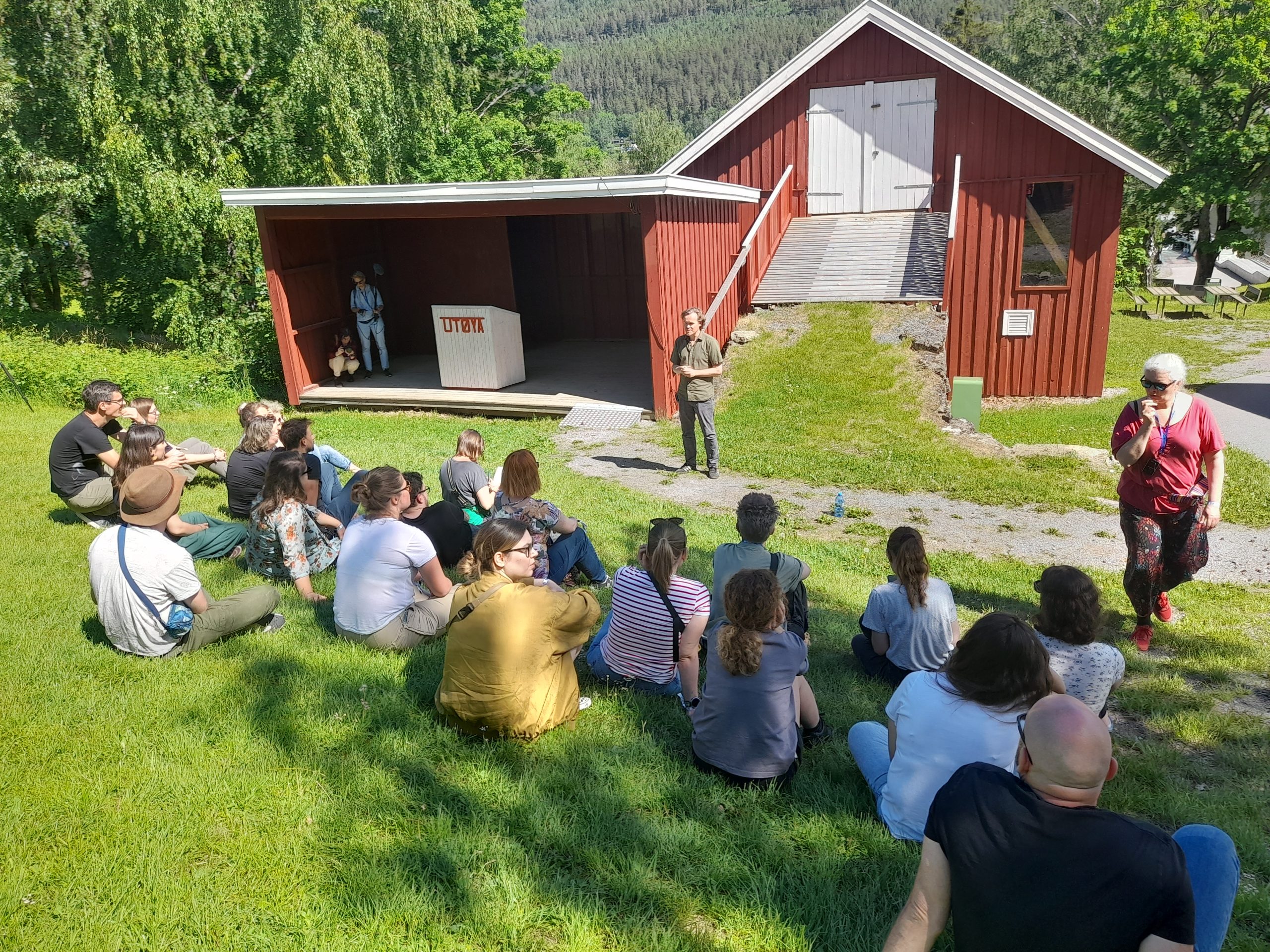
The recent elections to the European Parliament in which extreme right parties obtained very good results have shown that societies are becoming radicalized. This tendency is apparent in Europe and in the USA. Also, in Poland, radical views and groups are becoming stronger, and the dialogue between people representing diverse political options is becoming ever more difficult. Can we prevent it and how? A group of Polish non-governmental organisations working for democracy went to look for an answer to the Island of Utøya, where a Norwegian radical committed the biggest crime in the history of contemporary Norway.
There are 20 islands on the Norwegian Tyrifjorden lake, from tiny ones to the biggest, Storøya. Their number is not surprising, because this post-glacial lake is the fifth largest in the country. In some places its depth reaches almost 300 meters. The weather can change here several times per day, and when the wind starts to blow (as it often does) and the waves begin to hit the rocky cliffs, one may feel almost as if at a seacoast. Among the islands on Tyrifjorden lake Utøya (ut means “outside” in Norwegian, while øya means simply an island) is neither the biggest nor the smallest. One could think there is nothing that makes it stand out. And yet it is the one Island that drew the attention of the entire world 13 years ago.
July 22
On the 22nd of July, 2011, at 3:25 p.m., in the government district in Oslo a homemade, 950-kilogram bomb exploded. It damaged the seat of the prime minister and the facades of the neighbouring buildings and killed eight people. The person responsible for planting the bomb subsequently got into a car and drove towards the island of Utøya. He was dressed in a police uniform bought online and maintained he was from law enforcement. He told the employee operating the ferry to Utøya that because of the attack he came to take care of the safety of the youth staying there at a summer camp (there were over 500 people there). He was transported to the island together with a supply of weapons and at 5:20 p.m. he opened fire, first at the guards and the manager of Utøya, then at the youngsters. He hunted them for over one hour.
Right after the attack in Oslo it was universally believed that it was done by Al.-Kaida or another Islamic terrorist organisation. When at 6:34 p.m. the police arrested the attacker on Utøya, there was great surprise that the perpetrator was a single white male, Norwegian, Christian, ideologically conservative, who opposed the presence of Islam in Europe.
Island – symbol
This story cannot be compared to any of the other postwar fortunes of Norway. It stands in contradiction with the image of a country perceived as one of the safest in Europe and in contrast to the conviction that the greatest terrorist threat to the inhabitants of the Western states stems from Islam. It goes against the normal world order. It is also the largest massacre in history perpetrated by a single human being. In Norway, Utøya and 22 July became symbols of attacking democracy and defending democracy – we will stand firm in defending our values – Jens Stoltenberg, then Prime Minister of the country, said shortly after the bloody events in Oslo and on the island. – Norway’s response to violence will be more democracy, more openness and greater political participation.
‘This is not just any Island,’ emphasizes Lars Gudmundson, the director of Utøya Learning Centre and our guide here. ‘22nd July, 2011, a terrorist killed 69 people here, the majority of them very young.’
‘I’m not surprised that some of you have concerns about spending the night here,’ continues Lars. ‘That’s a natural reaction. But we’ll try to make you feel comfortable here. We really want you to leave here with better feelings compared to those you had when you came; with a belief in the power of dialogue and democracy.’
He directs these words to a Polish group that came to the Island to listen about and discuss the genesis of contemporary radicalism and methods to counteract it. And also to see how one may collectively experience and commemorate such a tragedy, how to talk about it without antagonizing. The group consists of representatives of twelve Polish NGOsi, involved in activities for democracy as well as organisers: Anna Fedas from the Stefan Batory Foundation and Ewa Stokłuska from the Education for Democracy Foundation. There is also Julia Pełka and Paulina Skibińska, documentary filmmakers (who are preparing a film summarizing a four-year programme of the Batory Foundation – Active Citizens – National Fund), Taida Meredith – interpreter and myself, who will write about the visit.
We are to spend three nights and three days on the Island, in small wooden houses, Norwegian hyttes standing among trees and furnished in a very simple manner.
Island of nature
Utøya can only be reached by boat or by the small ferry MS Thorbjørn, operated by employees of the local centre. We board it at the impressive concrete waterfront, which is part of a memorial that the state founded 11 years after the events of 22 July to commemorate the victims. It also includes a bronze installation – 77 narrow columns (each with the name, surname and age of one person killed that day in Oslo and on Utøya) that form a wave when viewed from above. Every year, on the anniversary of the events, eight columns commemorating the victims of the bomb attack in the government district indicate where the sun was when it happened. Another 69 show the sun’s path across the sky during the shooting on the island. We will find out about that later, but the memorial is impressive even without this information.
Standing beside it, we can see the island in the distance – peaceful, covered with woodland. As the ferry approaches and we disembark at the waterfront, we are struck by how beautiful Utøya is. Especially now, in June, when Norway’s wildlife is in full bloom. The wind rustles the leaves on the trees, the birds sing, the purple lupine and other field flowers are in bloom. Water washes over the rocky shores. Adding to the idyllic atmosphere is a white building with a high foundation and red roof opposite the marina, on which the name “Utøya” is written in red letters.
As we walk along the paths circling the island along the coast over the next few days, we will be struck more than once by the contrast of this idyllic setting and the events that have taken place here. But nature and life were here long before 22 July and are still here. So is democracy. The island’s hosts have made this idea their central message.
Island of youth
We start our walk around the island with Lars Gudmundson in front of the Utøya Learning Centre building, built after the massacre, in 2016. Inside, there is a canteen, a library and meeting rooms. This is where school groups and groups made up of representatives from different organisations, from Norway and internationally, come to learn about 22 July, as well as for training and workshops on preventing radicalisation. Such as our group.
It won’t be a long stroll, emphasises our guide, as the whole island can be walked around in 15-20 minutes. To start with, Lars shows us the meadow below, where participants pitch their tents during the summer camps. He then leads us up a grassy incline, sloping gently towards the marina where we have arrived. In front of us, on a flagpole, flies a rainbow flag (in Norway, this is how LGBT pride month is celebrated in June in many places). Down the slope stands a building with Norway’s characteristic brown and red wooden facade, one of the first to be built on Utøya. On our side it has a covered small stage with a white rostrum decorated with the island’s name. Lars explains that it is from here that politicians speak to the young people sitting on the hillside, and the young people argue with them.
To foster democracy, Norwegians teach it to children from a young age. The island of Utøya has for years hosted summer camps where young people meet Labour Party politicians, ask questions and challenge their decisions. It is a place that has nurtured many of Norway’s leading politicians, such as Jens Stoltenberg and Gro Harlem Brundtland, the first woman prime minister of the country, a position she has held three times.
‘Utøya’s history began long before the attack,’ Lars emphasises. ‘It explains why the island became a terrorist target. For years, young, socially engaged people who want to change the world have been coming here.’
Utøya was long privately owned. In the Middle Ages, it belonged to a monastery from nearby Storøya, and the monks created a herb garden here (hence the many species of locally uncommon plants that still grow here today). It then changed hands several times. The wooden building we are looking at dates from 1867 and was built by Gunerius Pettersen, a wealthy businessman from Oslo, as a granary for the summer house (the white building with red letters opposite the harbour). He and his partners used to holiday here. In the early 1930s, the owner at the time, Jens Kristian Bratlie, sold it to the left-wing Labour Party – which may come as a surprise, as he himself was a prominent member of the Norwegian Conservative Party and even speaker of parliament and later prime minister of the country on its behalf. Utøya became a centre for spreading views contrary to his own – left-wing, equality and democracy. Until the outbreak of the Second World War, the Labour Party and its Youth League organised summer camps for children from working-class families here. International politics, economics, the Spanish Civil War – these topics dominated the discussions held here. In 1936, Leon Trotsky visited Utøya and is said to have finished writing his legendary The Revolution Betrayed here. 1939 thrust the island once again into the hands of conservatives from the Norwegian Nazi Party, who held meetings and rallies here during the warmer months for members of their own youth group. In the winter, on the other hand, members of the resistance hid out on the island when it became deserted. After the war, the Labour Party regained its position as the largest and most influential in the country. In 1950, the Norwegian authorities decided to hand Utøya over to the Workers’ Youth League (AUF) and it is still in its hands today. The AUF holds training courses, reunions and youth camps here. It was on Utøya that Labour Party and AUF members discussed Norway’s potential accession to the EU (which did not happen) and looked for solutions when the party lost its majority in the elections. This small island has had a great influence on politics over the years.
‘Democracy, a multicultural and gender-equal society. It was these values, which Anders Behring Brevik blamed the Labour Party for spreading, when he struck on 22 July 2011,’ says Lars. ‘That’s why he planted a bomb outside the Prime Minister’s office in Oslo, and a few hours later on Utøya fired at young people who could become future party politicians.’
This is probably the only time when we hear the name of the terrorist during our visit. The employees of the foundation here don’t mention his name on purpose, focusing on the future and on commemoration of the victims. They want the voice to be theirs instead of the attacker’s message, his hatred and fear of “others”. There is also no thought of an enemy to take revenge on.
Island of memory
We follow Lars on the path around the Island being aware that it is where the youth was fleeing the terrorist. He shot at them wanting to kill as many as possible. We take a path behind the former summer house, we pass a meadow covered with lupine and reach a wooden building from 1950s, called „School”, where usually people with children used to stay. Lars says that fifty young people hid here, barricading windows and doors with mattresses. The attacker was shooting from the outside, but didn’t try to get in. All survived. This is exactly where the terrorist, who earlier called the police twice saying he wants to surrender, was apprehended. A few minutes after he shot dead the last three victims.
The path further is narrow and meanders at the edge of the island, under the trees. The coast at this side is made up off steep cliffs and the view of the lake brings to mind a Croatian seacoast or the Skellige Islands landscape from the game “The Witcher”.
‘We call these trails „kjærlighetsstien”, meaning paths of love,’ says Lars. ‘During camps, when several hundred people are on the Island, those longing for solitude or couples wanting some intimacy may find it here.’
Suddenly, just off the path, we see a ceramic bird and several little stone hearts, one has an inscription that can be translated as “loved and longed for”. On the pine tree next to it someone has attached a metal nameplate. Here, on this exact spot, Åsta Sofie was killed. As the terrorist walked around the island and kept firing while the teenagers ran away, no one knew if or where the bullets would reach them – on the path, in the building, on the cliffs, or maybe if they hid in the tall grass or tried to swim towards the mainland. Another thought strikes us. It only took us 10 minutes to get from one end of the island to the other, while the attacker on Utøya had been shooting for an hour and 15 minutes. With that size of the island, that’s a very long time.
Commemorating the victims of the tragedy that happened here is one of AUF’s main goals (in addition to education and political engagement) when considering the future of Utøya. Lars says that there was a long discussion with the families of the victims and survivors about how to do this. In 2015, the decision was made that life and summer camps would return to Utøya, an education centre and a memorial centre would be built. This sends a clear message to the world that the terrorist and his agenda did not prevail.
Lars shows us the “tree of values”- a spreading old pine tree on which flutter laminated sheets of paper in different colours. Survivors and relatives of the victims have been writing reminiscences and reflections on them. He then invites us inside the memorial centre – a large, modern building with a glass façade enclosed by openwork boards, simple and beautifully blending in with nature. On the ground floor there is a discussion space, there are educational games about democracy and human rights. In the corner stands an installation that resembles a large spiral notebook made of plywood. On each page is the name, surname and age; on some, photos and stories of the victims: 16-year-old Asta Sofie Helland Dahl (the one commemorated on the path) poses in a black topper, her peer Andrine Bakkene Espeland is seen in childhood and contemporary photos, 17-year-old Hakon – with tuba, guitar and girlfriend, Johanes Buo is 14 and puckered cheeks, and Karar Mustafa Quasim is a 19-year-old with a bold look and long dark hair. Some pages have no photographs, as Lars will explain to us, their families are not yet ready for their child’s life to be described in a few photos and a short text.
But most impressive is the former cafeteria building, which has been encased by the glass and wood building, trapping it like in a time capsule. That day, after the attacks in Oslo, many young people gathered in the cafeteria. They sat crowded in an interior steaming from the rain outside, dozens of wellingtons which they had removed on entering were lying by the door. The camp leaders and Monica Bosci, the island’s forty-five-year-old manager, wanted to inform the young people about the situation in the capital, to reassure them. Monika added that Utøya is a long way from Oslo and is the safest place to be (she soon became one of the first victims of the terrorist). Camp participants were found in the cafeteria by the armed assailant. He walked around inside and fired at close range at the young people frozen in terror. He killed 13 people, wounded many.
Today, you enter the cafeteria from inside the new building via a cracked concrete staircase, the same staircase that the terrorist climbed. The cafeteria’s rooms remember the 1970s and 1980s: the floor is linoleum, the walls are covered with painted white panelling and posters with socialist slogans, old folk furniture, an old-school projector at the entrance and a brown piano in front of it. By the walls lie small hearts of stone and glass with words of longing, angel figurines, dried flowers, photographs – of a red-haired boy in a yellow sweatshirt, a handsome blonde boy, a slim blonde girl with a rose and another one in folk costume, a boy with hair dyed red. They mark the places where bullets have reached them. Bullet marks can also be seen on the walls – in the thin wall opposite the entrance they made holes through, in the one under the window they stuck deep.
In the extension room at the end, facts about the attack were gathered. The day’s agenda includes morning gymnastics and the highlight – a meeting with former Prime Minister Gro Harlem Brundtland, adored by AUF youngsters (she was the terrorist’s top target, but had left the island just before the attack). Today we know that the football and basketball tournament scheduled for that day was cancelled due to rain, and the evening dance was cancelled after the events in Oslo. The time line on the wall shows step by step what the day of the attack looked like from the moment the bomb exploded in the government district. In addition to the hours and facts, the chart includes text messages from camp participants and their loved ones: I love you; I’m scared; someone is shooting; don’t call because we have to be quiet. Some of the dialogues on the island’s side abruptly stop. Next to it is a notice with the time of death. The cafeteria and this room is the most important part of the commemoration. We visit it in silence, individually. Fortunately, because here the voice and tears are stuck in our throats.
Our walk ends at the private memorial to the victims, which was funded by their families and survivors. Before it was built, they discussed at length what it should look like and where it should be erected.
Between the pine trees, on thin steel cables, floats a silver metal ring in which the names, surnames and ages of the victims are carved. When the memorial was set up five years after the tragedy, there were 60, but more were added as time went by and today there are 69. ‘No one rushed the memorial, some people need more time to mourn, others less, and we wanted to respect that,’ stresses Lars.
Island of education
The next few days are filled with lectures and meetings to show us how the education centre here carries out its mission. From Dr Christopher Fardan’s lecture on radical groups in Norway, we learn that although such views are the domain of only a few hundred people here, after 22 July the Centre for Research on Extremism C-REX at the University of Oslo was established to monitor radical groups. Zamran A. Butti and Maria Østby, educators at the Utøya Learning Centre, tell us about the long process that led to how to commemorate the victims of 22 July. About the discussions held with the victims’ families and survivors, about governmental and private forms of commemoration. And also about the project for a memorial in the form of a cut island, which was challenged by local residents as being too literal a reminder of the tragedy, and which for this reason was never built.
‘Everyone’s view of commemoration is different, so it requires a series of conversations, compromises and time to work out the best solutions. Creating a community and involving people has played a huge role in the whole process,’ says Zemran Butt, while Maria Østby adds: ‘We are proud that we have managed to do this on Utøya in such a way that many people find meaning in it.’
An important part of the commemoration is meeting survivors. Our group meets with Natia Chkhetiani. The dark-haired Georgian became involved in politics in her country in 2009, after the Rose Revolution. She was 20 years old. She quickly became the chairwoman of a left-wing youth group. In July 2011, she and Tamta, her best friend and secretary of her group, arrived at the invitation of AUF activists for a summer camp in Utøya – excited and hungry for inspiration. Tamta was killed in the attack, Natia survived. In a calm voice she talks about the camp, the events of that day and how she could not find understanding in her native Georgia after the assault. There, the terrorist was reduced to a madman and the political aspect of his act was ignored. Seeking understanding, she moved to Norway – she lives in Oslo, has a family and a job with an environmental organisation. She is in touch with other survivors and is involved in the activities of the education centre. She feels that by doing so she remains true to the values she and her friend believed in.
Island of the future
At the end of each day we share our impressions and try to sort out what we have seen and heard. Thoughts and perspectives clash, because in our group there are people from social organisations with very different profiles: helping refugees on the Polish-Belarusian border, working with teachers and schoolchildren on equality, countering violence and prejudice, working in local communities and with minorities, and commemorating the victims of historical events. All, however, work in the field of dialogue and all have come here to learn how to confront radicalisation.
When I ask them if they encounter radical attitudes in the course of their work, everyone has something to say. ‘At the border, this is our everyday life. We experience radical attitudes and behaviour from border guards, for example, who point guns at us and send patrols near our homes several times a day,’ says Kaja Kojder-Demska from the Bezkres Foundation, which helps refugees on the Polish-Belarusian border. The intensification of both anti-Israeli and anti-Palestinian attitudes after the outbreak of war in the Gaza Strip is discussed by Blanka Blaszczak-Rozenbaum and Ewelina Kaczmarczyk from the Salam Lab Peace Action Laboratory Association, which counteracts Islamophobia, and Rachela Antosz-Rekucka and Jakub Antosz-Rekucki from the Sztetl Mszana Dolna Foundation, which commemorates the local Jewish community. Marcin Urbanek and Łukasz Mieszkowski from the Common Forms Foundation, which designs monuments and commemorations, speak of pressure to ensure that the commemoration at the Sobibor extermination camp they worked on emphasises literal elements (the gas chamber building) and thus to radicalise Israeli young people who come here on tours. Monika and Jan Marković from the Podkarpackie Association for Active Families, which works for children’s rights and gender equality, talk about teenage girls who were boiling over with aggression and anger towards men at the anti-gender violence workshops they organised. Barbara Michalska from the EduKABE Foundation for Creative Solutions, which supports teachers, talks about young boys from schools in Łódź who wear T-shirts with the slogan “Poland for Poles”.
So we hold discussions in the library of the education centre and during strolls in groups along the paths of love. Until late, because in June the sun sets over the horizon here after 10 pm, and it is still bright at midnight. We try to extract thoughts that we will take with us to Poland and to further activities.
‘I travelled here with trepidation as to what it would be like to be in a place where something like this had happened. The big and positive surprise for me was that I spent these few days well, not feeling sad all the time,’ says Marcin from the Common Forms Foundation, ‘For me, the masterpiece here is leaving the cafeteria as a memorial, but hidden in a new building, blending in with the surroundings, nature. It is part of Utøya, but it doesn’t impose itself.’
‘For me, a big inspiration is the role nature plays here,’ continues Ewa Romanowska from the Borussia Foundation in Olsztyn, which deals with local memory. ‘Arriving here, we see trees, not a monument. I feel that the main actor is life, not death.’
‘When we go to the forest on the border and look for people, we sharpen our gaze differently. For a long time we feared that this forest would never be ours again. But even now we are able to stop to pick wild strawberries, we reclaim it in this way,’ adds Kaja from the Bezkres Foundation. ‘Here, I was moved by the enclosing of the space to remember the tragedy, and reclaiming the rest of the island for life. Thanks to this, although it is a place of fear and sadness, it was easy for us to laugh here, to have fun, to sing songs in the evening with the guitar. We see the future here. It’s a great inspiration, we don’t get many lessons like this.’
‘What struck me was that this commemoration of the tragedy is so different from what we know,’ stresses Łukasz from the Common Forms Foundation. ‘It’s not encased in bronze or concrete, but it’s a process, it’s happening all the time, and it invites education and conversation, the acquisition of knowledge, the creation of identity.’
‘I was deeply moved by the encounter with the traces of the tragedy. There were two moments in particular – the photographs, the hearts and flowers in the cafeteria and the bullet marks,’ says Julian Czurko from the Fruit of the Meeting Foundation (Fundacja Owoc Spotkania), which works with young people. ‘But then I came out of there to take a breath for a moment and saw that downstairs in this new building there was a circle of empty chairs, waiting to be sat on and start a dialogue. And when dialogue starts, violence ends.’
‘Being confronted with the information about the age of the people who died was very difficult for me, as it probably is for every parent, because I have children who are not much younger,’ shares Jan. ‘That’s why it was very important to meet Natya, a survivor who talked about the trauma, but also about having a job, a four-year-old child and a normal life. I would very much like to hear more stories of survivors and families of victims, to find out how they are coping with it.’
‘I was impressed by the modesty of the commemoration, the lack of pathos, deflation of the balloon,’ says Kornelia Kurowska from the Borussia Foundation.’ As Lars told us: ‘we want people to feel better when they leave here compared to when they come to Utøya. And this is working. And why? Because they are taught to respond practically to a situation of difference. Those who acquire the competence to be with others in spite of differences will not become radicalised. We in Poland have lost this and we have lost the ability to be in community. The ideas that cemented it – religion, statehood – have fallen apart.’
‘In Poland we also have a problem talking about difficult experiences. The way they talk about 22 July here will stay with me for a long time,’ emphasises Barbara from EduKABE. ‘No exaltation, no pointing at the guilty party. It resonated strongly that it is not the perpetrator who is important, but those who died and those who survived who grew afterwards. This opens the door to dialogue, to future action.’
‘The analogy with the Smolensk catastrophe is the first thing that came to my mind,’ says Ewa Stokłuska from the Education for Democracy Foundation. ‘Here they gave themselves time before the commemoration was set up, there was space for conversation, a desire for it to bring together different needs. In our country, we erected monuments right away. And nobody engaged in dialogue with the families of the victims about it.’
‘In our country, even in a disaster situation, we were looking for the guilty party, the enemy behind it. This was the focus of the most important part of the narrative and it divided people very much,’ someone adds.
‘Here, the multiple perspectives are emphasised all the time: those of the parents, the survivors, the public, while at home in the case of Smolensk there was a game of appropriation of arguments, of who is right,’ says Julian.
‘The focus here on the future and at the same time the cultivation of values: openness, dialogue, living with diversity, acceptance of differences – all this is supposedly simple and I know it, but I feel that I have looked at it from a different perspective and I have become newly motivated to focus on it,’ says Ewa from the Education for Democracy Foundation.
‘Being here for a few days, learning about the context, the history of the island – before and after the attack, seeing that they don’t want to give the narrative to the terrorist, they are building not only on the idea that this history should not repeat itself, but on the positives, the desire to change the world, it makes you think about the future,’ concludes Anna Fedas from the Stefan Batory Foundation.
Island of memory. Birthday.
‘We returned, new buildings have been built, an education centre has been set up, camps are being held. That’s how we responded to the attack,’ emphasises Lars. ‘The response is also all the people involved, the survivors who return here to tell their stories and those who come here to learn something, like you. The most important group among them are young people between the ages of 15 and 25. We tell them how to cope when they have a conflict with someone in class or online and how we can live together despite our differences. We debate, we have games, we discuss cases. We always emphasise that a lack of acceptance of otherness leads to extremism, and from hate speech it is close to hateful acts’.
Before we board the ferry that will take us to the mainland, Zamran from the Utøya Learning Centre invites us to a special celebration. Today would have been Espen Jorgensen’s 30th birthday. We go to the memorial funded by the families, a silver metal ring suspended between the trees, and put a red rose – the symbol of the Labour Party – and field flowers in Espen’s name. Zamran reads out a remembrance of the boy who came to Utøya for the first time, full of hope, plans for the future and a desire to do things, and told his parents on the phone that it was the best week of his life.
This is how the birthdays of each of the dead are celebrated here, along with the groups that happen to be on the island. With the thought that we will remember the unknown boy and 76 others, as well as the power of dialogue, we board the ferry. As we bounce off the shore, it occurs to me that changing the world is not some utopian idea. It is something that makes sense and can save us.
The visit to Utøya Island took place in June 2024 and was organised as part of the Active Citizens Fund – National programme in cooperation with the Active Citizens Fund- Regional programme.
Text: Agnieszka Wójcińska
The report was published on Onet.pl
